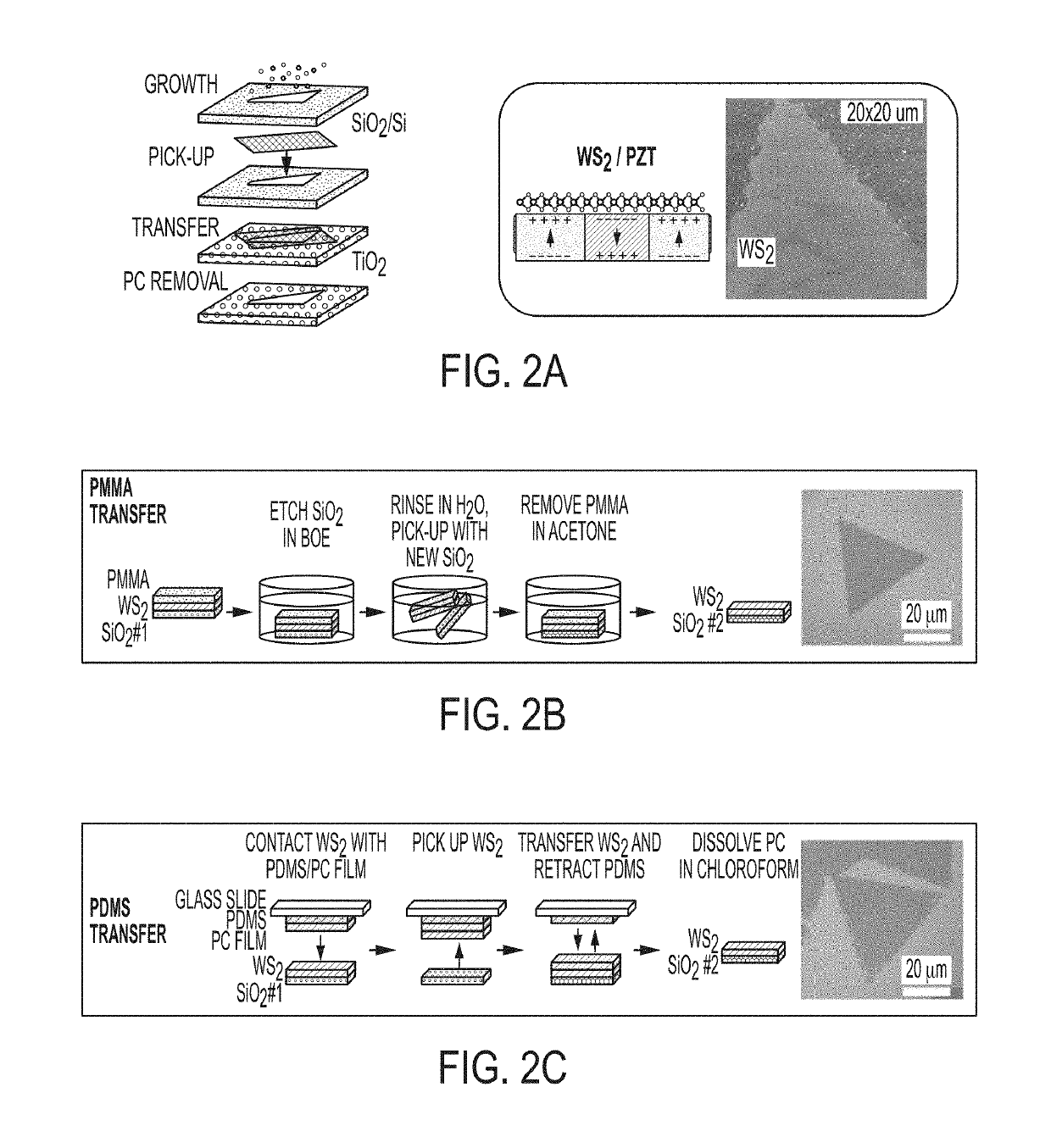Controlling structural phase transitions and properties of two-dimensional materials by integrating with multiferroic layers
a two-dimensional material and phase transition technology, applied in the field of heterostructures, can solve the problems of inability to change, several drawbacks of conventional methods,
- Summary
- Abstract
- Description
- Claims
- Application Information
AI Technical Summary
Benefits of technology
Problems solved by technology
Method used
Image
Examples
example 1
[0049]One method for mechanically transferring a TMD monolayer, such as WS2, onto a substrate, such as a ferroelectric film, includes the use of a PMMA film, as illustrated in FIG. 2B. A sample including a layer of WS2 on an SiO2 substrate is coated with a thin layer of PMMA (polymethyl methacrylate) resist and cured on a hot plate at 100° C. for 10 minutes, then submerged in buffered hydrofluoric acid to etch the SiO2, freeing the WS2 from the growth substrate. Once fully etched, the film was rinsed in deionized H2O, where it floated on the surface, and was then lifted from the water using the desired substrate. Optionally, adhesion of the WS2 layer may be improved by spinning at 2000 rpm and baking at 100° C. An acetone and isopropanol soak removes the PMMA. An optical image of PMMA transferred WS2 exhibits a uniform, clean, triangular shape, and is also shown in FIG. 2B.
example 2
[0050]Another method for mechanically transferring a TMD monolayer, such as WS2, onto a substrate, such as a ferroelectric film, includes the use of a PDMS / PC film, as illustrated in FIG. 2C. A sample including a layer of WS2 on an SiO2 substrate is brought into contact a PDMS / PC film, then retracted. This moves the WS2 from Si / SiO2 onto the PDMS / PC film. The PDMS / PC / WS2 stack is then placed onto clean Si / SiO2. The PDMS stamp is retracted, leaving the PC film on the top surface of WS2, which is then dissolved in chloroform. An optical image following PDMS transfer is shown in FIG. 2C.
example 3
[0051]Polarization domains were written into a 150 nm PZT / Pt / SiO2 / Si test sample using a conductive atomic force microscope (CAFM) manufactured by Park Systems (Suwon, South Korea), in order to demonstrate that polarization domains in the ferroelectric film control photoluminescence (PL) intensity of mechanically transferred WS2 monolayers. The sample is shown in FIG. 3
[0052]The 6×6 micron image shown in FIG. 3 was obtained using the AFM operating in electric force microscopy imaging mode. The dark regions of the image correspond to the areas of the sample in which the AFM created dipole domains pointing up. The light regions of the image correspond to the areas of the sample in which the AFM created dipole domains pointing down. This is shown schematically in the accompanying cross section corresponding to the fiducial line drawn through the image. While the dipole domains shown here are about 500 nm in lateral dimension, domains on the scale of a few nanometers can also be success...
PUM
| Property | Measurement | Unit |
|---|---|---|
| thickness | aaaaa | aaaaa |
| bias voltage | aaaaa | aaaaa |
| bias voltage | aaaaa | aaaaa |
Abstract
Description
Claims
Application Information
 Login to View More
Login to View More - R&D
- Intellectual Property
- Life Sciences
- Materials
- Tech Scout
- Unparalleled Data Quality
- Higher Quality Content
- 60% Fewer Hallucinations
Browse by: Latest US Patents, China's latest patents, Technical Efficacy Thesaurus, Application Domain, Technology Topic, Popular Technical Reports.
© 2025 PatSnap. All rights reserved.Legal|Privacy policy|Modern Slavery Act Transparency Statement|Sitemap|About US| Contact US: help@patsnap.com



